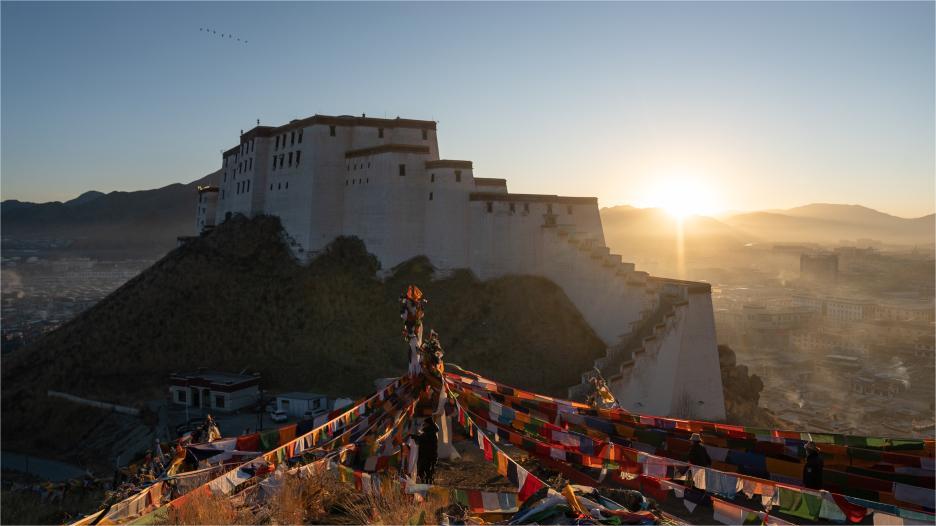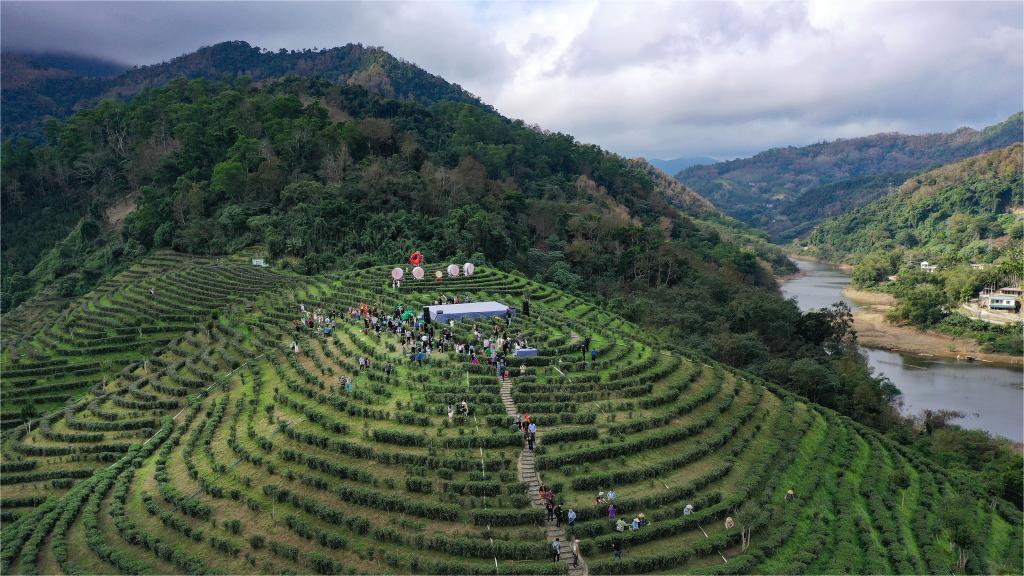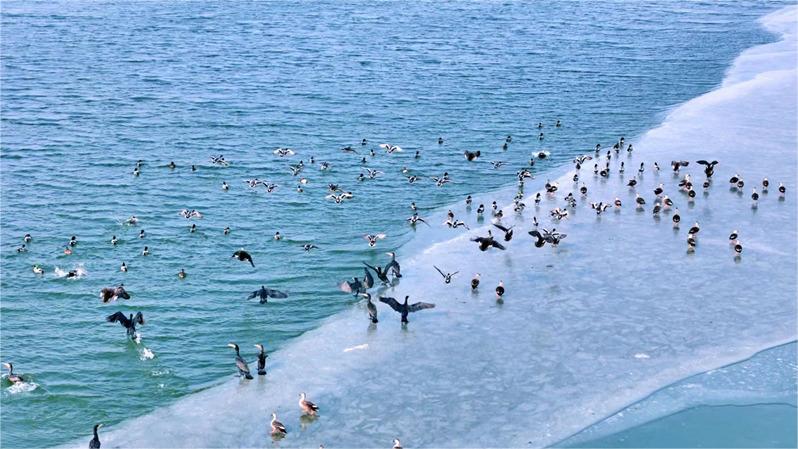Social media fuels tourism boom in China
BEIJING, Jan. 16 (Xinhua) -- An artificial moon illuminating the St. Sophia Cathedral, hot air balloons gracefully floating over the Songhua River, a dazzling ice-snow theme park wowing visitors, the Oroqen ethnic minority people and their reindeer adding a unique cultural touch... Welcome to the enchanting winter wonderland that Harbin has passionately crafted for all to experience.
Since the start of this year's ice and snow season, short videos showcasing these incredible scenes in the northeastern Chinese city have gone viral on social media platforms across the world.

An aerial drone photo taken on Jan. 9, 2024 shows tourists having fun near a giant snowman in Harbin, northeast China's Heilongjiang Province. (Xinhua/Zhang Tao)
"My wife and I had thought about going to Thailand for a winter trip, but we were attracted by the viral short videos depicting ice-and-snow fun in Harbin. So, we are here now," said Sun Chengzhe, a tourist from east China's Fujian Province.
UNPARALLELED HOSPITALITY
Dubbed as China's "ice city," Harbin, capital of Heilongjiang Province, boasts a history of more than six decades of celebrating the ice and snow festival. The first ice lantern exhibition was held here in 1963.
To attract more tourists, the city has stepped up its efforts this year. The Ice and Snow World, a prominent theme park situated on the northern bank of the Songhua River, has expanded to 810,000 square meters, marking its largest scale since it first opened in 1999. A total of 250,000 cubic meters of ice and snow were harvested from the river to build fairy-tale castles, towers and slides.
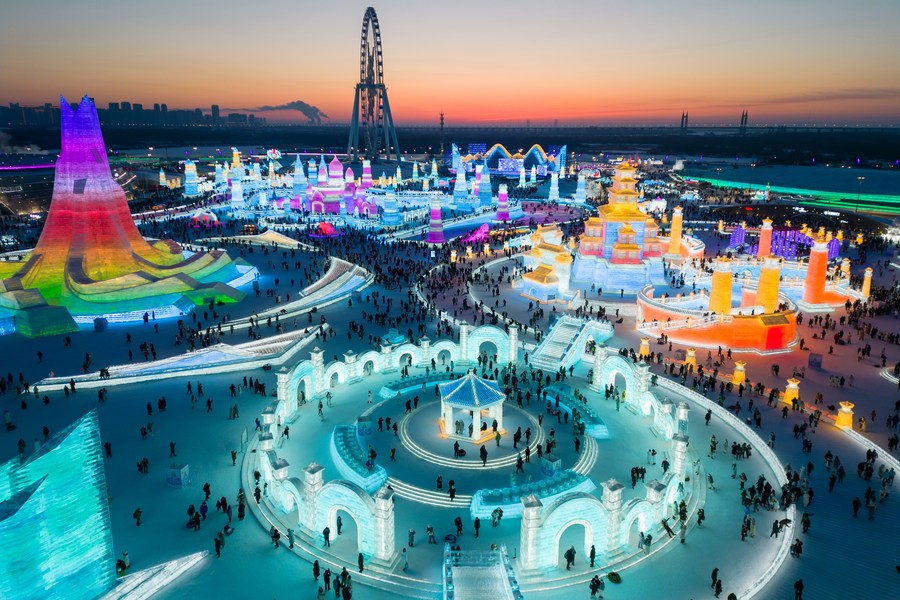
An aerial drone photo taken on Dec. 31, 2023 shows tourists having fun at Harbin Ice-Snow World in Harbin, northeast China's Heilongjiang Province. (Xinhua/Zhang Tao)
An array of activities, including live performances, firework displays, intangible heritage culture shows and concerts, have been introduced. In addition, a series of measures have been rolled out to improve the city's dining, accommodation, travel, shopping and entertainment so as to enhance the visitor experience.
The city's residents have also pitched in to showcase their hospitality, with locals volunteering to offer free rides at train stations and on streets to tourists.
"I am deeply touched by the local people's warmth and friendliness. From the moment I got off the train, taxi drivers and restaurant owners I've encountered along the way have constantly recommended places to visit. What's more amazing is that during the peak tourist season, you can ride the subway for free," said Xing Xinyu, a tourist from Shanxi Province.

An aerial drone photo taken on Jan. 9, 2024 shows tourists walking on the Central Street in Harbin, capital of northeast China's Heilongjiang Province. (Xinhua/Zhang Tao)
Thanks to the concerted efforts, Harbin's popularity among tourists has skyrocketed. During the three-day New Year holiday, it received more than 3 million visitors, raking in 5.91 billion yuan (about 831.97 million U.S. dollars) of tourism revenue. Both the number of tourists and the amount of tourism revenue surpassed the figures for 2019, marking a historical peak.
According to the "top 10 cities for ice-snow tourism in 2024" released earlier this month by China Tourism Academy, Harbin has claimed the top spot.
RECIPE FOR SUCCESS
Becoming the standout tourism attraction is not merely a stroke of luck, but the result of meticulous planning and focused efforts.

A tourist dressed up in costumes poses for photos at a square in Harbin, northeast China's Heilongjiang Province, Jan. 12, 2024. (Xinhua/Wang Jianwei)
"Since the past year, we have continuously enhanced our market-oriented thinking and service awareness," said He Jing, director of the provincial culture and tourism department, adding that the promotion of tourism through social media platforms was piloted in early 2023.
He noted that related departments attach great importance to tourists' demands on social media platforms and make timely adjustments. For instance, in response to tourists expressing a desire to take photos at the St. Sophia Cathedral, a former Russian Orthodox church, against the backdrop of a radiant moon, local authorities installed a large artificial moon above the Neo-Byzantine architecture.

Chief conductor Zhang Yong delivers breakfast for kids from south China's Guangxi Zhuang Autonomous Region on the train K7042 that links Mohe and Harbin in northeast China's Heilongjiang Province, Jan. 6, 2024. These kids, nicknamed "little tangerines" referring to a specialty produce of their native Guangxi, quickly went viral among netizens as they embarked on a "brave" camp trip to northeast China. (Photo by Xu Shuai/Xinhua)
One of the most popular short videos showcasing winter tourism in Harbin features a group of young tourists aged between three and six years old from the southern Guangxi Zhuang Autonomous Region, attracting nationwide attention.
As Guangxi is a major producer of tangerines and the young tourists wore orange-colored coats, they have been called "little sweet tangerines" by netizens.
To show their gratitude for the warmth extended to the Guangxi children, Guangxi announced the exemption of tickets at its 45 tourist attractions for people from the northeastern regions.
"I had heard about tourism in the northeastern regions long before, but the short videos have encouraged more people, including me, to practically experience it," said Deng Xiao, a tourist traveling in Yanji, Jilin Province.
Experts believe that the online interaction between Heilongjiang and Guangxi has not only promoted tourism in both regions but also introduced local specialties such as Guangxi tangerines and Heilongjiang cranberries, unlocking a mutually beneficial approach for promoting the cultural and tourism development of cities.

People line up to get cranberries distributed for free from northeast China's Heilongjiang Province at a distribution site in Nanning, south China's Guangxi Zhuang Autonomous Region, Jan. 11, 2024. (Xinhua/Cao Yiming)
"The surge in ice-snow tourism in Harbin is closely related to promotions on social media platforms, especially short video platforms. Through 'internet thinking,' such as gathering public opinions online and creating online and offline interactions, Harbin as a 'celebrity city' has become even more popular as a tourist destination," said Tian Lei, a professor of journalism and communication at Heilongjiang University.
Many regions have been inspired by Heilongjiang's success and plan to follow suit to boost the winter tourism and ice-and-snow economy. "This serves as a good example of China driving economic development and stimulating consumption through 'internet thinking,'" Tian added.
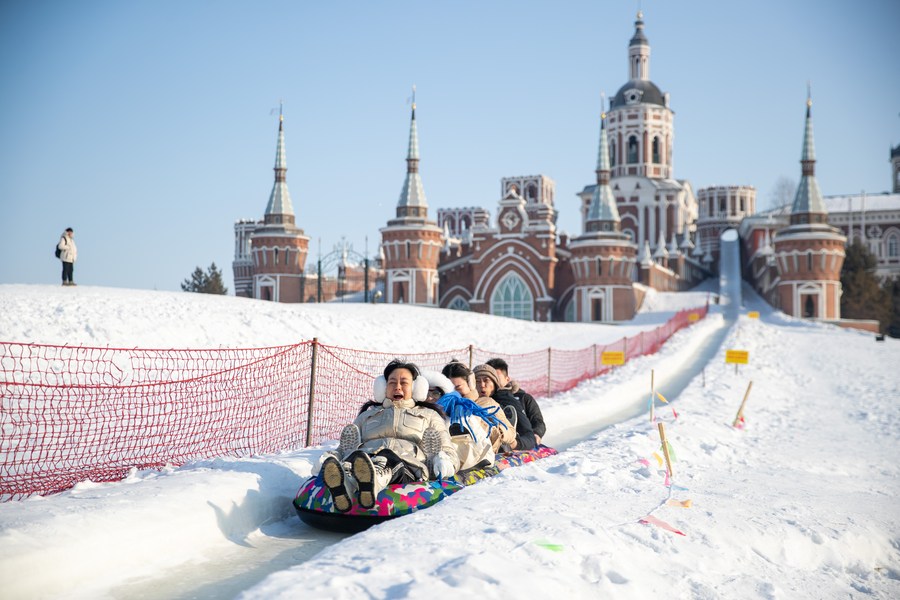
People enjoy themselves at the Volga Manor in Harbin, northeast China's Heilongjiang Province, Jan. 7, 2024. (Xinhua/Zhang Tao)
Social media platforms have also played a crucial role in revitalizing the tourism market in other cities like Chongqing, Chengdu and Zibo.
"The promotion of culture and tourism needs the support of online traffic, yet it goes beyond mere online presence. Ensuring the longevity of popularity and maintaining lasting appeal can only be achieved through the continuous improvement of services and the introduction of innovative cultural and tourism products," said Zhu Baokun, operations director of a popular tourism attraction in Jilin.
Photos
Related Stories
- Growing north-south travels underline winter tourism vigor
- Supply-side reforms unleash momentum in China's ice-and-snow economy
- Winter tourism booms across nation
- China implements measures to facilitate foreigners visiting China, relaxing visa application requirements
- Friendly visa policies to help boost tourism
Copyright © 2024 People's Daily Online. All Rights Reserved.







